Auditing and Ethics | Report
VerifiedAdded on 2022/09/01
|12
|2828
|37
AI Summary
Contribute Materials
Your contribution can guide someone’s learning journey. Share your
documents today.
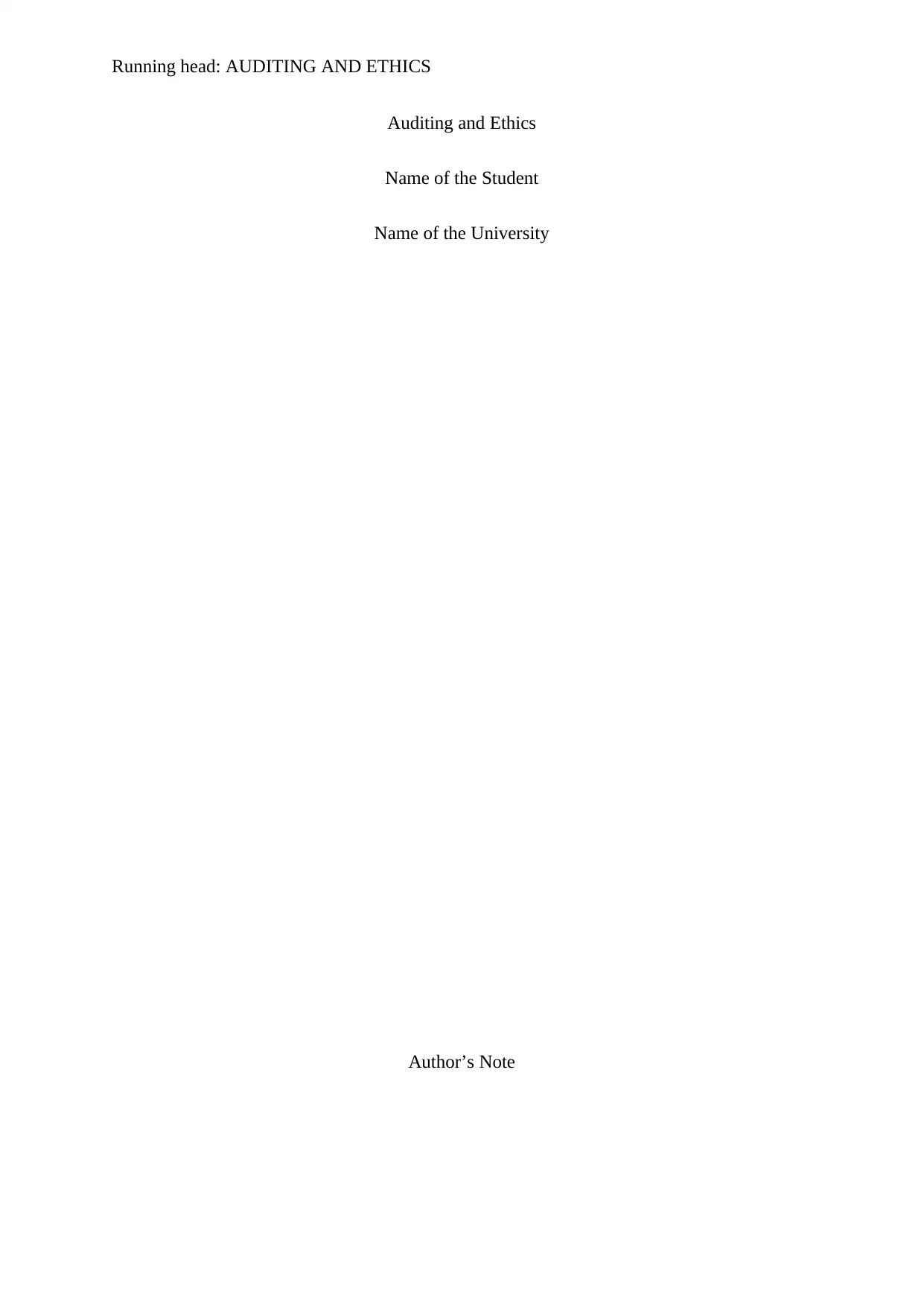
Running head: AUDITING AND ETHICS
Auditing and Ethics
Name of the Student
Name of the University
Author’s Note
Auditing and Ethics
Name of the Student
Name of the University
Author’s Note
Secure Best Marks with AI Grader
Need help grading? Try our AI Grader for instant feedback on your assignments.
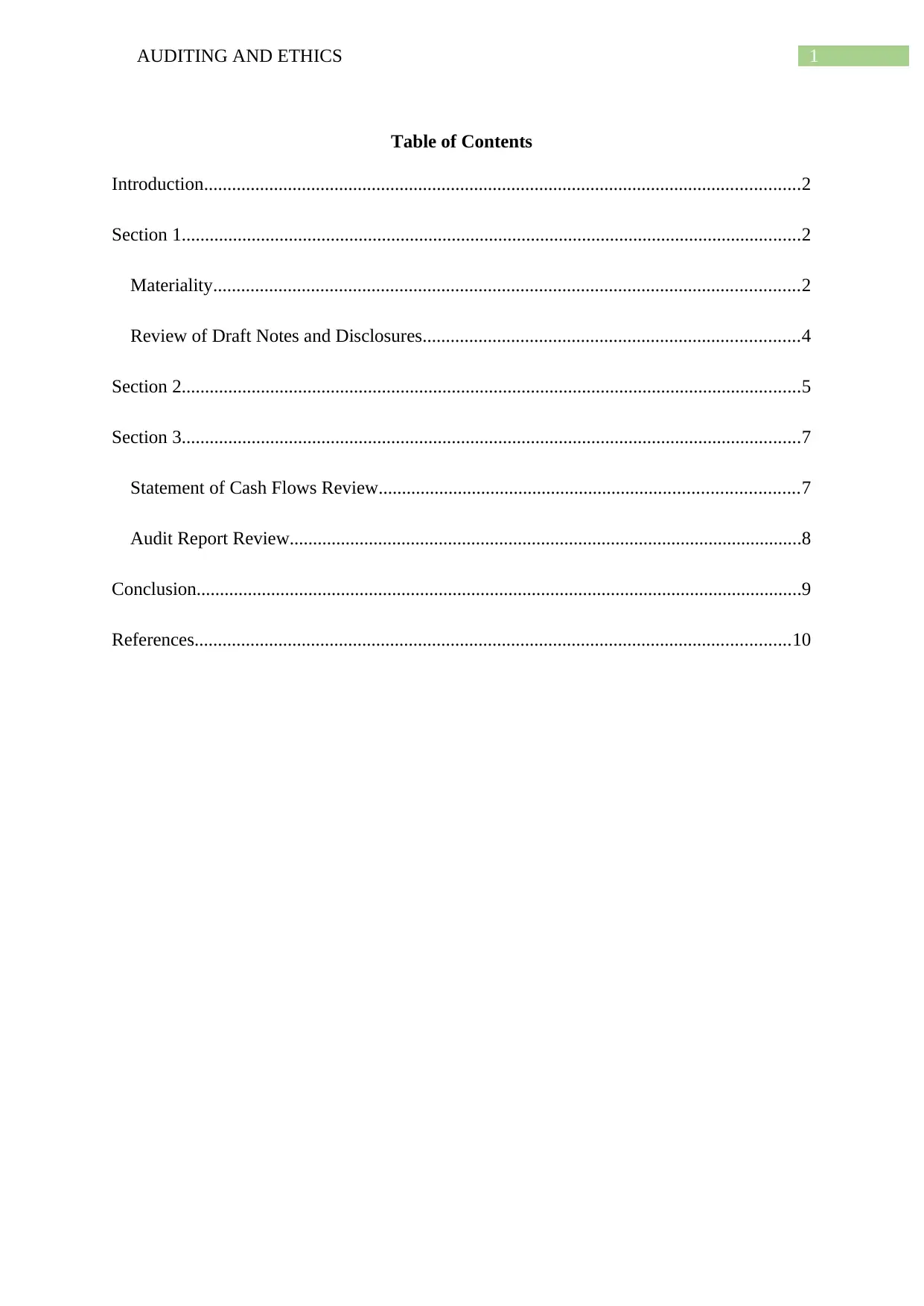
1AUDITING AND ETHICS
Table of Contents
Introduction................................................................................................................................2
Section 1.....................................................................................................................................2
Materiality..............................................................................................................................2
Review of Draft Notes and Disclosures.................................................................................4
Section 2.....................................................................................................................................5
Section 3.....................................................................................................................................7
Statement of Cash Flows Review..........................................................................................7
Audit Report Review..............................................................................................................8
Conclusion..................................................................................................................................9
References................................................................................................................................10
Table of Contents
Introduction................................................................................................................................2
Section 1.....................................................................................................................................2
Materiality..............................................................................................................................2
Review of Draft Notes and Disclosures.................................................................................4
Section 2.....................................................................................................................................5
Section 3.....................................................................................................................................7
Statement of Cash Flows Review..........................................................................................7
Audit Report Review..............................................................................................................8
Conclusion..................................................................................................................................9
References................................................................................................................................10
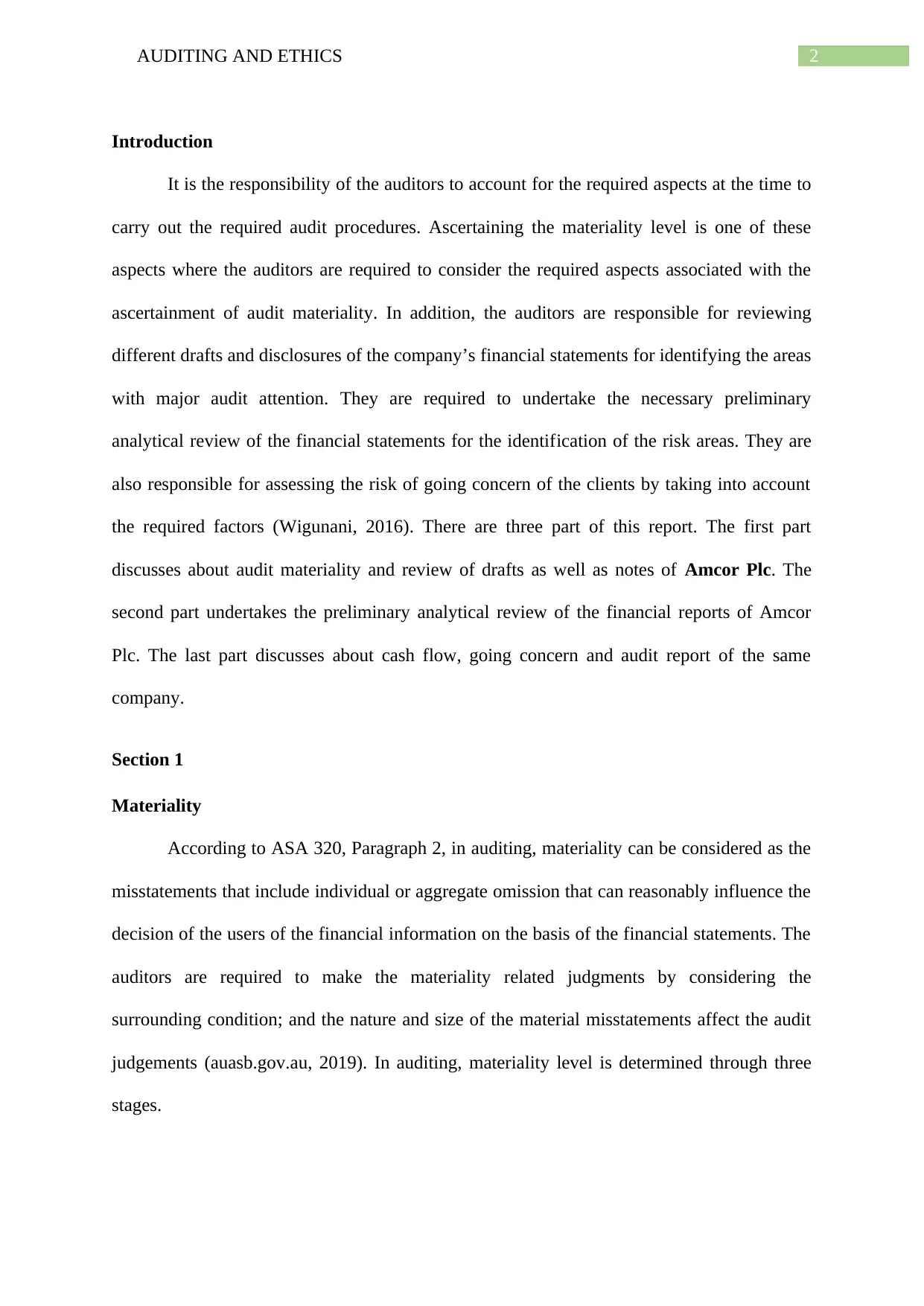
2AUDITING AND ETHICS
Introduction
It is the responsibility of the auditors to account for the required aspects at the time to
carry out the required audit procedures. Ascertaining the materiality level is one of these
aspects where the auditors are required to consider the required aspects associated with the
ascertainment of audit materiality. In addition, the auditors are responsible for reviewing
different drafts and disclosures of the company’s financial statements for identifying the areas
with major audit attention. They are required to undertake the necessary preliminary
analytical review of the financial statements for the identification of the risk areas. They are
also responsible for assessing the risk of going concern of the clients by taking into account
the required factors (Wigunani, 2016). There are three part of this report. The first part
discusses about audit materiality and review of drafts as well as notes of Amcor Plc. The
second part undertakes the preliminary analytical review of the financial reports of Amcor
Plc. The last part discusses about cash flow, going concern and audit report of the same
company.
Section 1
Materiality
According to ASA 320, Paragraph 2, in auditing, materiality can be considered as the
misstatements that include individual or aggregate omission that can reasonably influence the
decision of the users of the financial information on the basis of the financial statements. The
auditors are required to make the materiality related judgments by considering the
surrounding condition; and the nature and size of the material misstatements affect the audit
judgements (auasb.gov.au, 2019). In auditing, materiality level is determined through three
stages.
Introduction
It is the responsibility of the auditors to account for the required aspects at the time to
carry out the required audit procedures. Ascertaining the materiality level is one of these
aspects where the auditors are required to consider the required aspects associated with the
ascertainment of audit materiality. In addition, the auditors are responsible for reviewing
different drafts and disclosures of the company’s financial statements for identifying the areas
with major audit attention. They are required to undertake the necessary preliminary
analytical review of the financial statements for the identification of the risk areas. They are
also responsible for assessing the risk of going concern of the clients by taking into account
the required factors (Wigunani, 2016). There are three part of this report. The first part
discusses about audit materiality and review of drafts as well as notes of Amcor Plc. The
second part undertakes the preliminary analytical review of the financial reports of Amcor
Plc. The last part discusses about cash flow, going concern and audit report of the same
company.
Section 1
Materiality
According to ASA 320, Paragraph 2, in auditing, materiality can be considered as the
misstatements that include individual or aggregate omission that can reasonably influence the
decision of the users of the financial information on the basis of the financial statements. The
auditors are required to make the materiality related judgments by considering the
surrounding condition; and the nature and size of the material misstatements affect the audit
judgements (auasb.gov.au, 2019). In auditing, materiality level is determined through three
stages.
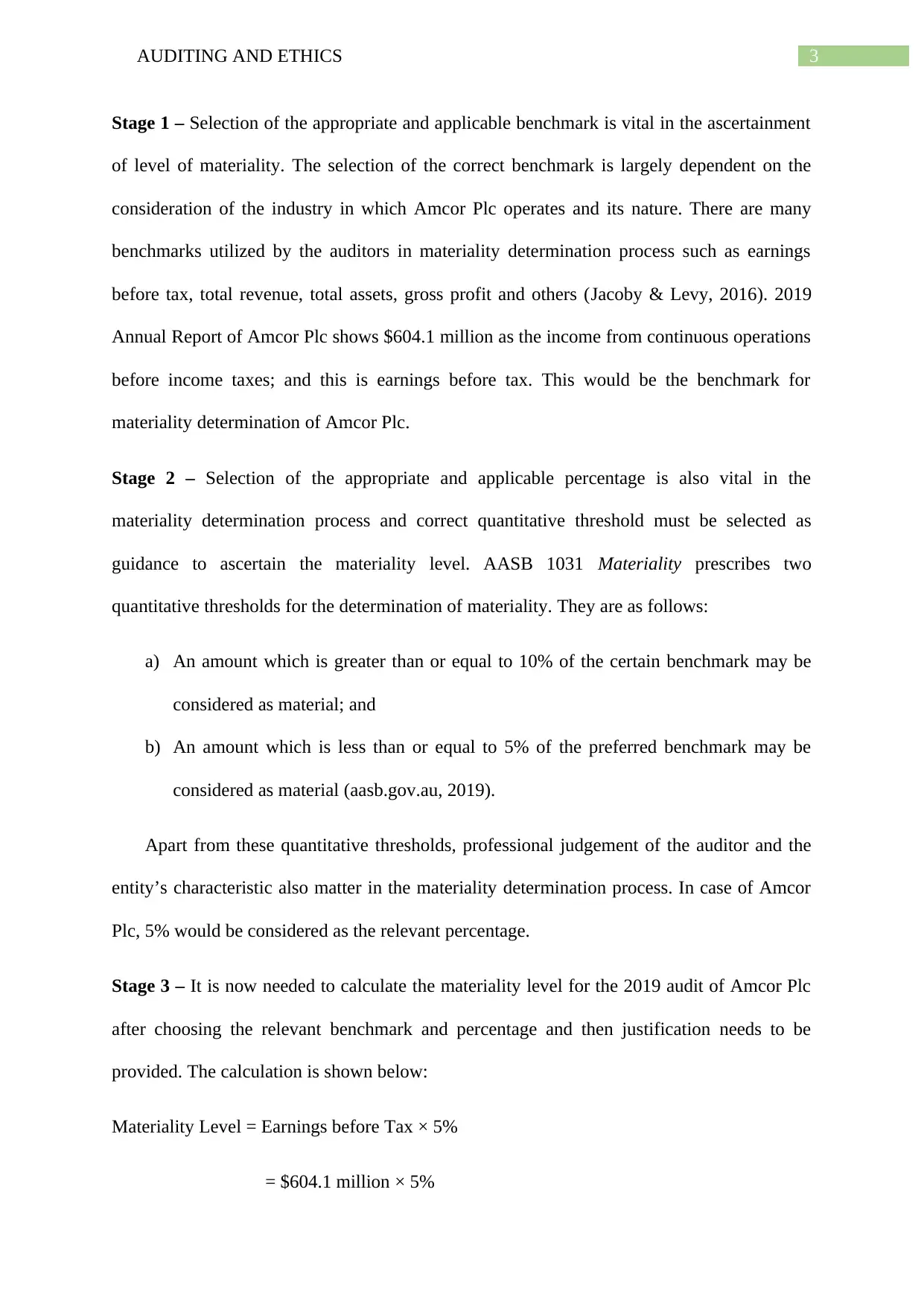
3AUDITING AND ETHICS
Stage 1 – Selection of the appropriate and applicable benchmark is vital in the ascertainment
of level of materiality. The selection of the correct benchmark is largely dependent on the
consideration of the industry in which Amcor Plc operates and its nature. There are many
benchmarks utilized by the auditors in materiality determination process such as earnings
before tax, total revenue, total assets, gross profit and others (Jacoby & Levy, 2016). 2019
Annual Report of Amcor Plc shows $604.1 million as the income from continuous operations
before income taxes; and this is earnings before tax. This would be the benchmark for
materiality determination of Amcor Plc.
Stage 2 – Selection of the appropriate and applicable percentage is also vital in the
materiality determination process and correct quantitative threshold must be selected as
guidance to ascertain the materiality level. AASB 1031 Materiality prescribes two
quantitative thresholds for the determination of materiality. They are as follows:
a) An amount which is greater than or equal to 10% of the certain benchmark may be
considered as material; and
b) An amount which is less than or equal to 5% of the preferred benchmark may be
considered as material (aasb.gov.au, 2019).
Apart from these quantitative thresholds, professional judgement of the auditor and the
entity’s characteristic also matter in the materiality determination process. In case of Amcor
Plc, 5% would be considered as the relevant percentage.
Stage 3 – It is now needed to calculate the materiality level for the 2019 audit of Amcor Plc
after choosing the relevant benchmark and percentage and then justification needs to be
provided. The calculation is shown below:
Materiality Level = Earnings before Tax × 5%
= $604.1 million × 5%
Stage 1 – Selection of the appropriate and applicable benchmark is vital in the ascertainment
of level of materiality. The selection of the correct benchmark is largely dependent on the
consideration of the industry in which Amcor Plc operates and its nature. There are many
benchmarks utilized by the auditors in materiality determination process such as earnings
before tax, total revenue, total assets, gross profit and others (Jacoby & Levy, 2016). 2019
Annual Report of Amcor Plc shows $604.1 million as the income from continuous operations
before income taxes; and this is earnings before tax. This would be the benchmark for
materiality determination of Amcor Plc.
Stage 2 – Selection of the appropriate and applicable percentage is also vital in the
materiality determination process and correct quantitative threshold must be selected as
guidance to ascertain the materiality level. AASB 1031 Materiality prescribes two
quantitative thresholds for the determination of materiality. They are as follows:
a) An amount which is greater than or equal to 10% of the certain benchmark may be
considered as material; and
b) An amount which is less than or equal to 5% of the preferred benchmark may be
considered as material (aasb.gov.au, 2019).
Apart from these quantitative thresholds, professional judgement of the auditor and the
entity’s characteristic also matter in the materiality determination process. In case of Amcor
Plc, 5% would be considered as the relevant percentage.
Stage 3 – It is now needed to calculate the materiality level for the 2019 audit of Amcor Plc
after choosing the relevant benchmark and percentage and then justification needs to be
provided. The calculation is shown below:
Materiality Level = Earnings before Tax × 5%
= $604.1 million × 5%
Secure Best Marks with AI Grader
Need help grading? Try our AI Grader for instant feedback on your assignments.
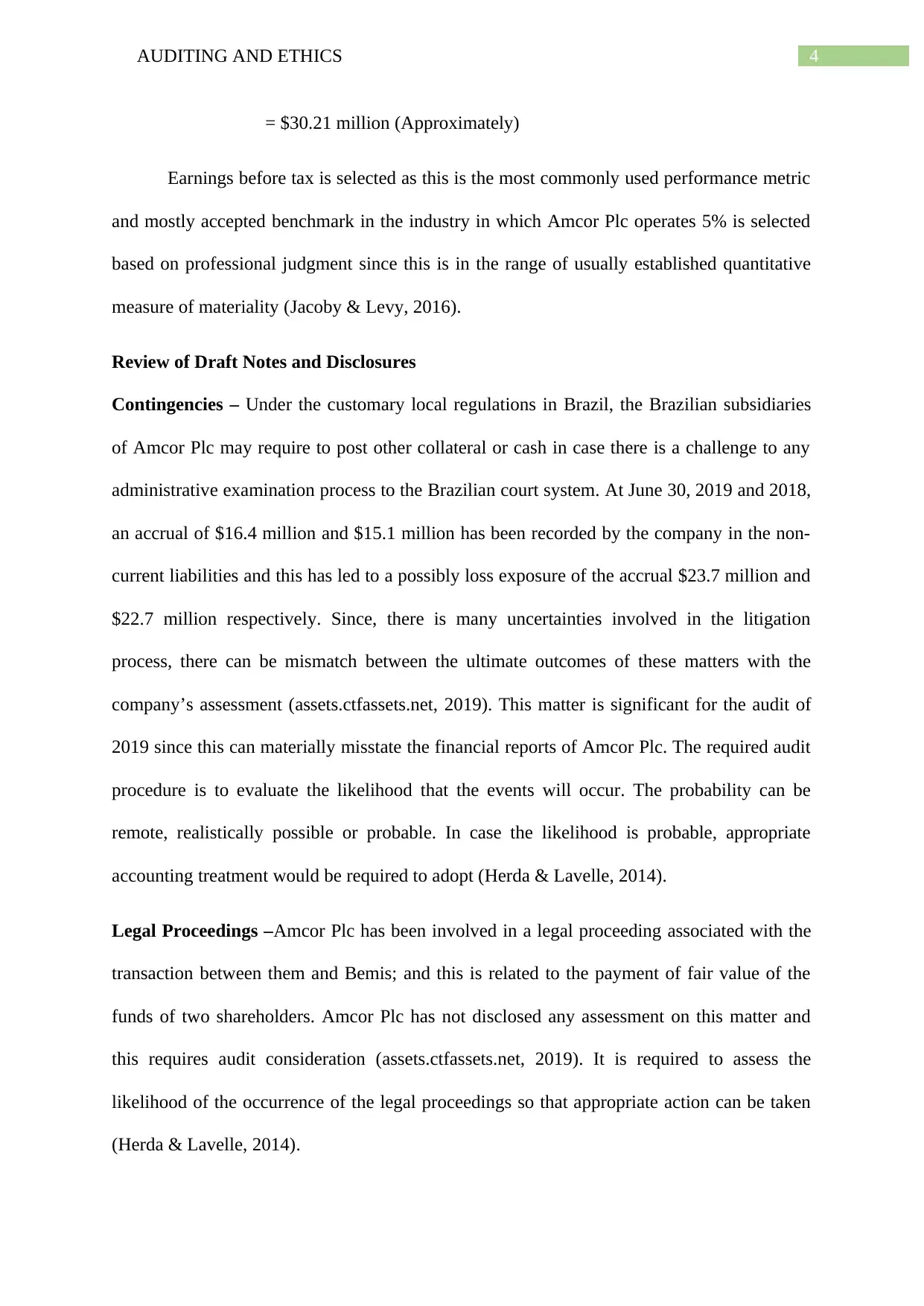
4AUDITING AND ETHICS
= $30.21 million (Approximately)
Earnings before tax is selected as this is the most commonly used performance metric
and mostly accepted benchmark in the industry in which Amcor Plc operates 5% is selected
based on professional judgment since this is in the range of usually established quantitative
measure of materiality (Jacoby & Levy, 2016).
Review of Draft Notes and Disclosures
Contingencies – Under the customary local regulations in Brazil, the Brazilian subsidiaries
of Amcor Plc may require to post other collateral or cash in case there is a challenge to any
administrative examination process to the Brazilian court system. At June 30, 2019 and 2018,
an accrual of $16.4 million and $15.1 million has been recorded by the company in the non-
current liabilities and this has led to a possibly loss exposure of the accrual $23.7 million and
$22.7 million respectively. Since, there is many uncertainties involved in the litigation
process, there can be mismatch between the ultimate outcomes of these matters with the
company’s assessment (assets.ctfassets.net, 2019). This matter is significant for the audit of
2019 since this can materially misstate the financial reports of Amcor Plc. The required audit
procedure is to evaluate the likelihood that the events will occur. The probability can be
remote, realistically possible or probable. In case the likelihood is probable, appropriate
accounting treatment would be required to adopt (Herda & Lavelle, 2014).
Legal Proceedings –Amcor Plc has been involved in a legal proceeding associated with the
transaction between them and Bemis; and this is related to the payment of fair value of the
funds of two shareholders. Amcor Plc has not disclosed any assessment on this matter and
this requires audit consideration (assets.ctfassets.net, 2019). It is required to assess the
likelihood of the occurrence of the legal proceedings so that appropriate action can be taken
(Herda & Lavelle, 2014).
= $30.21 million (Approximately)
Earnings before tax is selected as this is the most commonly used performance metric
and mostly accepted benchmark in the industry in which Amcor Plc operates 5% is selected
based on professional judgment since this is in the range of usually established quantitative
measure of materiality (Jacoby & Levy, 2016).
Review of Draft Notes and Disclosures
Contingencies – Under the customary local regulations in Brazil, the Brazilian subsidiaries
of Amcor Plc may require to post other collateral or cash in case there is a challenge to any
administrative examination process to the Brazilian court system. At June 30, 2019 and 2018,
an accrual of $16.4 million and $15.1 million has been recorded by the company in the non-
current liabilities and this has led to a possibly loss exposure of the accrual $23.7 million and
$22.7 million respectively. Since, there is many uncertainties involved in the litigation
process, there can be mismatch between the ultimate outcomes of these matters with the
company’s assessment (assets.ctfassets.net, 2019). This matter is significant for the audit of
2019 since this can materially misstate the financial reports of Amcor Plc. The required audit
procedure is to evaluate the likelihood that the events will occur. The probability can be
remote, realistically possible or probable. In case the likelihood is probable, appropriate
accounting treatment would be required to adopt (Herda & Lavelle, 2014).
Legal Proceedings –Amcor Plc has been involved in a legal proceeding associated with the
transaction between them and Bemis; and this is related to the payment of fair value of the
funds of two shareholders. Amcor Plc has not disclosed any assessment on this matter and
this requires audit consideration (assets.ctfassets.net, 2019). It is required to assess the
likelihood of the occurrence of the legal proceedings so that appropriate action can be taken
(Herda & Lavelle, 2014).
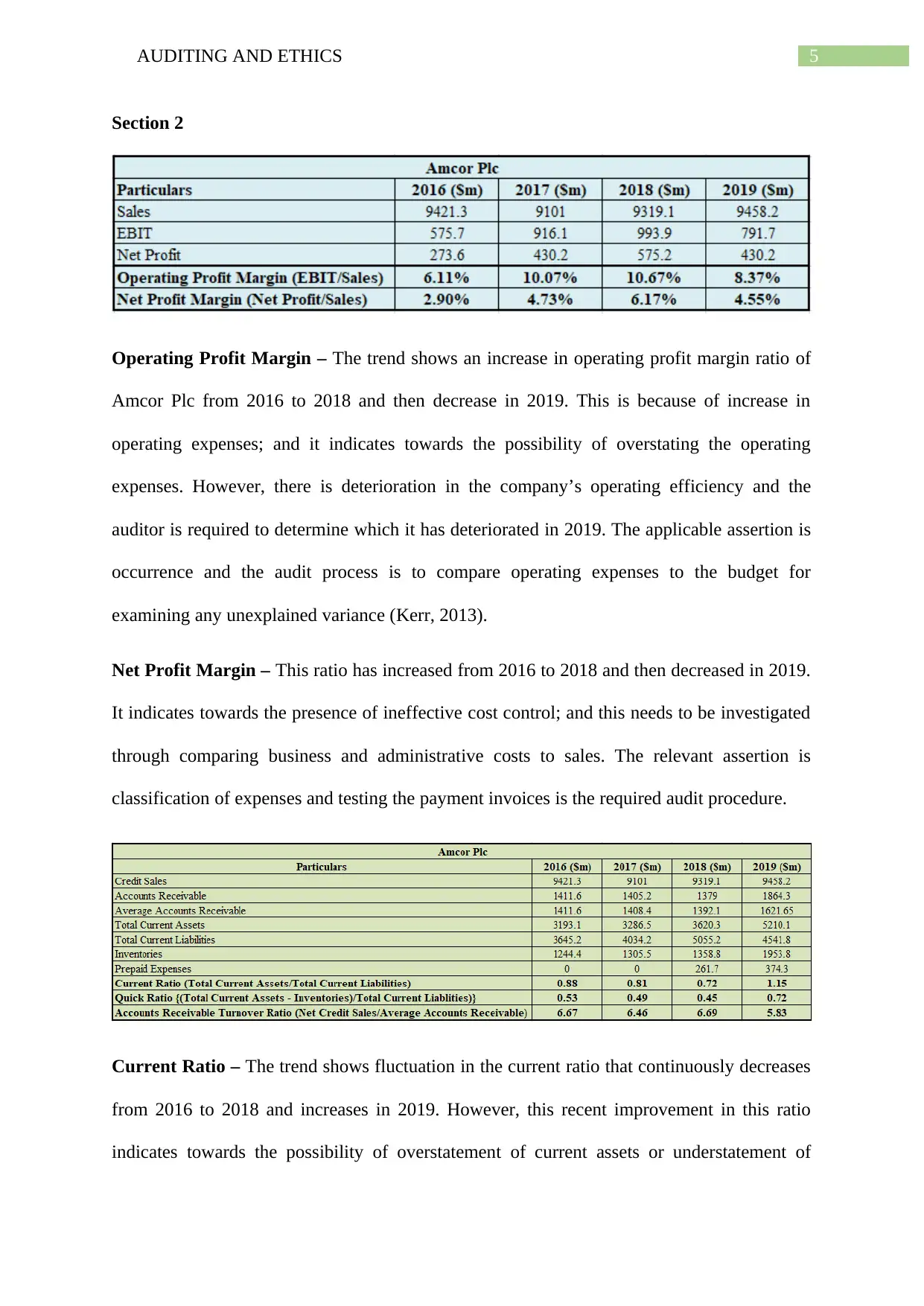
5AUDITING AND ETHICS
Section 2
Operating Profit Margin – The trend shows an increase in operating profit margin ratio of
Amcor Plc from 2016 to 2018 and then decrease in 2019. This is because of increase in
operating expenses; and it indicates towards the possibility of overstating the operating
expenses. However, there is deterioration in the company’s operating efficiency and the
auditor is required to determine which it has deteriorated in 2019. The applicable assertion is
occurrence and the audit process is to compare operating expenses to the budget for
examining any unexplained variance (Kerr, 2013).
Net Profit Margin – This ratio has increased from 2016 to 2018 and then decreased in 2019.
It indicates towards the presence of ineffective cost control; and this needs to be investigated
through comparing business and administrative costs to sales. The relevant assertion is
classification of expenses and testing the payment invoices is the required audit procedure.
Current Ratio – The trend shows fluctuation in the current ratio that continuously decreases
from 2016 to 2018 and increases in 2019. However, this recent improvement in this ratio
indicates towards the possibility of overstatement of current assets or understatement of
Section 2
Operating Profit Margin – The trend shows an increase in operating profit margin ratio of
Amcor Plc from 2016 to 2018 and then decrease in 2019. This is because of increase in
operating expenses; and it indicates towards the possibility of overstating the operating
expenses. However, there is deterioration in the company’s operating efficiency and the
auditor is required to determine which it has deteriorated in 2019. The applicable assertion is
occurrence and the audit process is to compare operating expenses to the budget for
examining any unexplained variance (Kerr, 2013).
Net Profit Margin – This ratio has increased from 2016 to 2018 and then decreased in 2019.
It indicates towards the presence of ineffective cost control; and this needs to be investigated
through comparing business and administrative costs to sales. The relevant assertion is
classification of expenses and testing the payment invoices is the required audit procedure.
Current Ratio – The trend shows fluctuation in the current ratio that continuously decreases
from 2016 to 2018 and increases in 2019. However, this recent improvement in this ratio
indicates towards the possibility of overstatement of current assets or understatement of
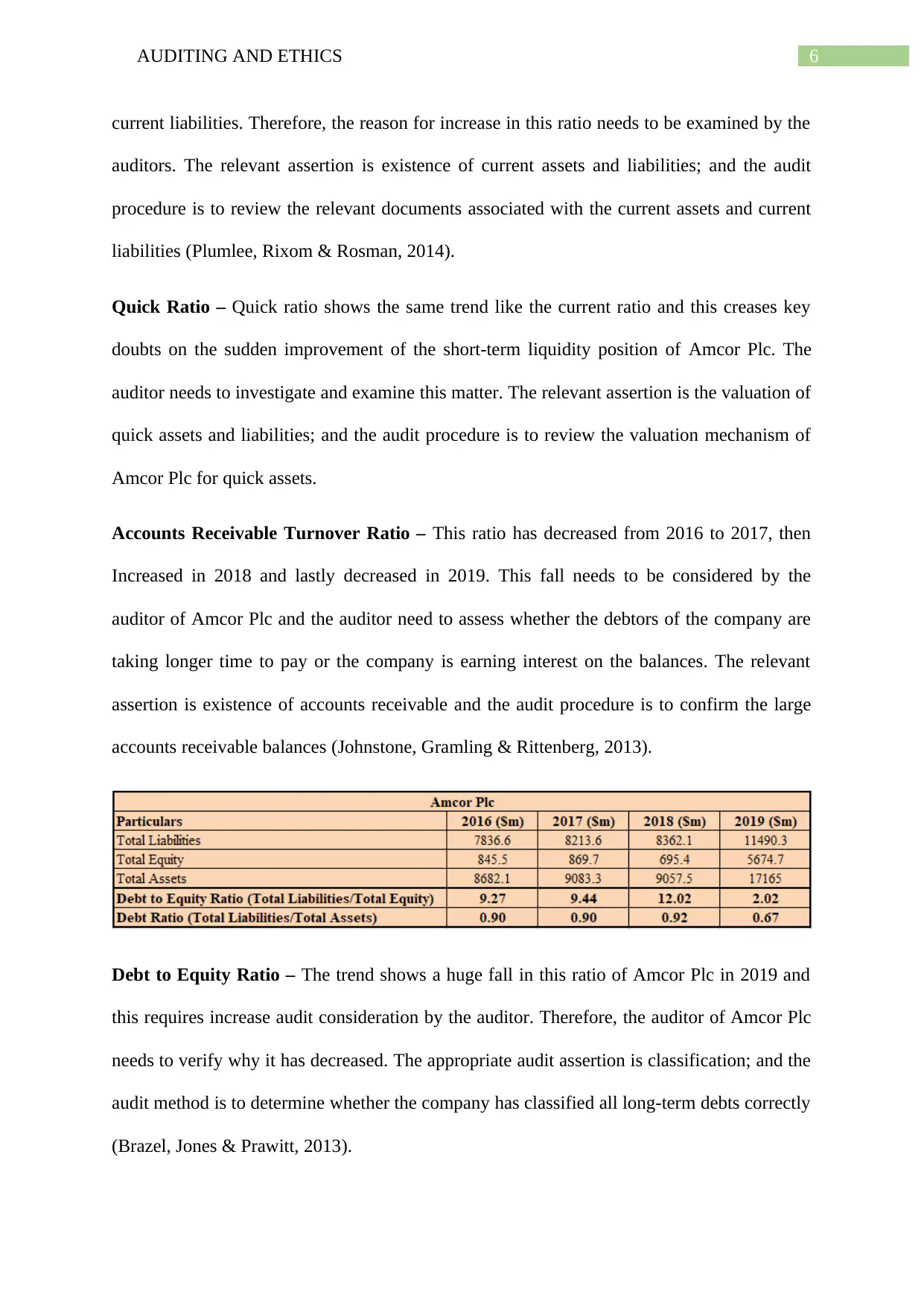
6AUDITING AND ETHICS
current liabilities. Therefore, the reason for increase in this ratio needs to be examined by the
auditors. The relevant assertion is existence of current assets and liabilities; and the audit
procedure is to review the relevant documents associated with the current assets and current
liabilities (Plumlee, Rixom & Rosman, 2014).
Quick Ratio – Quick ratio shows the same trend like the current ratio and this creases key
doubts on the sudden improvement of the short-term liquidity position of Amcor Plc. The
auditor needs to investigate and examine this matter. The relevant assertion is the valuation of
quick assets and liabilities; and the audit procedure is to review the valuation mechanism of
Amcor Plc for quick assets.
Accounts Receivable Turnover Ratio – This ratio has decreased from 2016 to 2017, then
Increased in 2018 and lastly decreased in 2019. This fall needs to be considered by the
auditor of Amcor Plc and the auditor need to assess whether the debtors of the company are
taking longer time to pay or the company is earning interest on the balances. The relevant
assertion is existence of accounts receivable and the audit procedure is to confirm the large
accounts receivable balances (Johnstone, Gramling & Rittenberg, 2013).
Debt to Equity Ratio – The trend shows a huge fall in this ratio of Amcor Plc in 2019 and
this requires increase audit consideration by the auditor. Therefore, the auditor of Amcor Plc
needs to verify why it has decreased. The appropriate audit assertion is classification; and the
audit method is to determine whether the company has classified all long-term debts correctly
(Brazel, Jones & Prawitt, 2013).
current liabilities. Therefore, the reason for increase in this ratio needs to be examined by the
auditors. The relevant assertion is existence of current assets and liabilities; and the audit
procedure is to review the relevant documents associated with the current assets and current
liabilities (Plumlee, Rixom & Rosman, 2014).
Quick Ratio – Quick ratio shows the same trend like the current ratio and this creases key
doubts on the sudden improvement of the short-term liquidity position of Amcor Plc. The
auditor needs to investigate and examine this matter. The relevant assertion is the valuation of
quick assets and liabilities; and the audit procedure is to review the valuation mechanism of
Amcor Plc for quick assets.
Accounts Receivable Turnover Ratio – This ratio has decreased from 2016 to 2017, then
Increased in 2018 and lastly decreased in 2019. This fall needs to be considered by the
auditor of Amcor Plc and the auditor need to assess whether the debtors of the company are
taking longer time to pay or the company is earning interest on the balances. The relevant
assertion is existence of accounts receivable and the audit procedure is to confirm the large
accounts receivable balances (Johnstone, Gramling & Rittenberg, 2013).
Debt to Equity Ratio – The trend shows a huge fall in this ratio of Amcor Plc in 2019 and
this requires increase audit consideration by the auditor. Therefore, the auditor of Amcor Plc
needs to verify why it has decreased. The appropriate audit assertion is classification; and the
audit method is to determine whether the company has classified all long-term debts correctly
(Brazel, Jones & Prawitt, 2013).
Paraphrase This Document
Need a fresh take? Get an instant paraphrase of this document with our AI Paraphraser
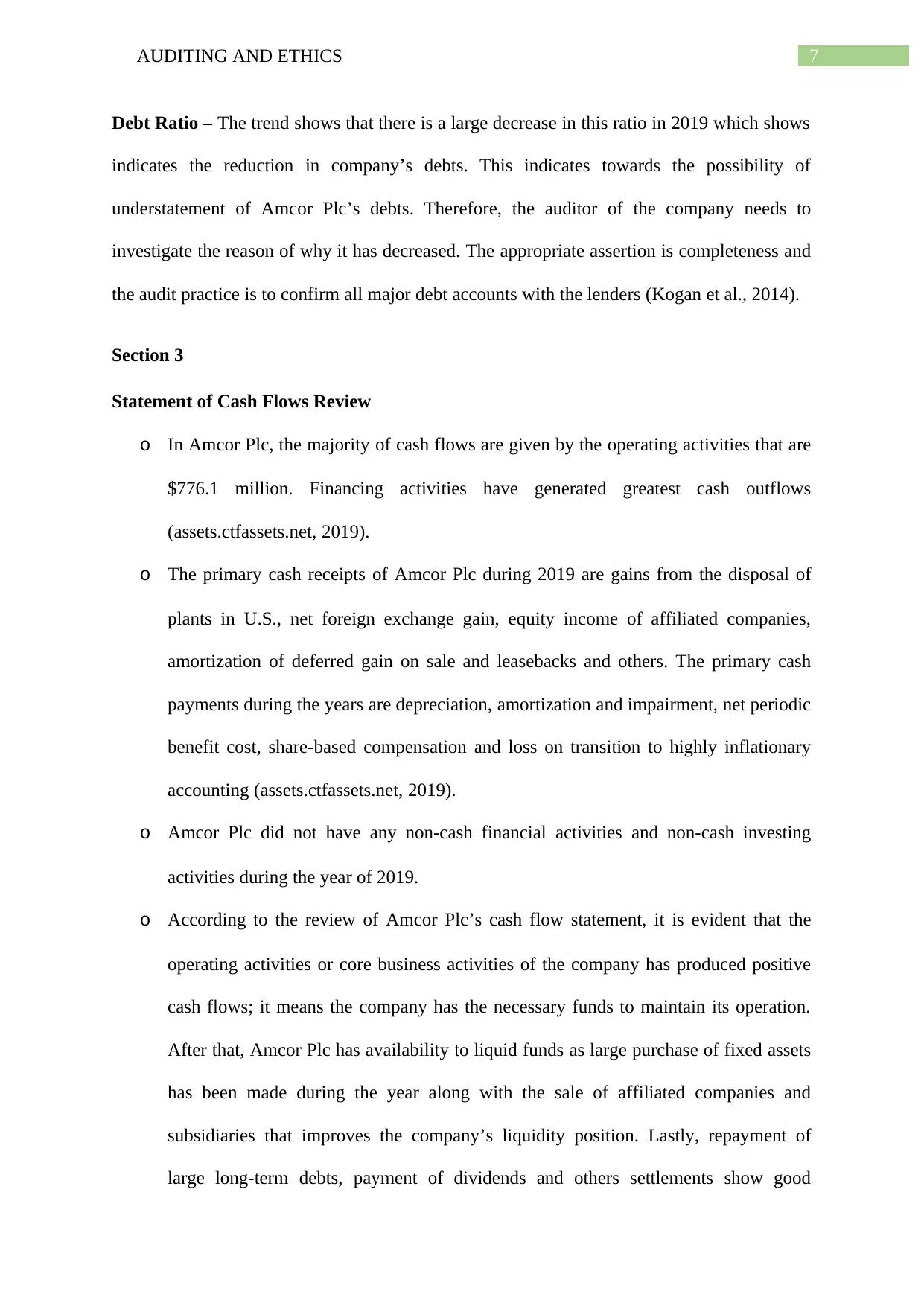
7AUDITING AND ETHICS
Debt Ratio – The trend shows that there is a large decrease in this ratio in 2019 which shows
indicates the reduction in company’s debts. This indicates towards the possibility of
understatement of Amcor Plc’s debts. Therefore, the auditor of the company needs to
investigate the reason of why it has decreased. The appropriate assertion is completeness and
the audit practice is to confirm all major debt accounts with the lenders (Kogan et al., 2014).
Section 3
Statement of Cash Flows Review
o In Amcor Plc, the majority of cash flows are given by the operating activities that are
$776.1 million. Financing activities have generated greatest cash outflows
(assets.ctfassets.net, 2019).
o The primary cash receipts of Amcor Plc during 2019 are gains from the disposal of
plants in U.S., net foreign exchange gain, equity income of affiliated companies,
amortization of deferred gain on sale and leasebacks and others. The primary cash
payments during the years are depreciation, amortization and impairment, net periodic
benefit cost, share-based compensation and loss on transition to highly inflationary
accounting (assets.ctfassets.net, 2019).
o Amcor Plc did not have any non-cash financial activities and non-cash investing
activities during the year of 2019.
o According to the review of Amcor Plc’s cash flow statement, it is evident that the
operating activities or core business activities of the company has produced positive
cash flows; it means the company has the necessary funds to maintain its operation.
After that, Amcor Plc has availability to liquid funds as large purchase of fixed assets
has been made during the year along with the sale of affiliated companies and
subsidiaries that improves the company’s liquidity position. Lastly, repayment of
large long-term debts, payment of dividends and others settlements show good
Debt Ratio – The trend shows that there is a large decrease in this ratio in 2019 which shows
indicates the reduction in company’s debts. This indicates towards the possibility of
understatement of Amcor Plc’s debts. Therefore, the auditor of the company needs to
investigate the reason of why it has decreased. The appropriate assertion is completeness and
the audit practice is to confirm all major debt accounts with the lenders (Kogan et al., 2014).
Section 3
Statement of Cash Flows Review
o In Amcor Plc, the majority of cash flows are given by the operating activities that are
$776.1 million. Financing activities have generated greatest cash outflows
(assets.ctfassets.net, 2019).
o The primary cash receipts of Amcor Plc during 2019 are gains from the disposal of
plants in U.S., net foreign exchange gain, equity income of affiliated companies,
amortization of deferred gain on sale and leasebacks and others. The primary cash
payments during the years are depreciation, amortization and impairment, net periodic
benefit cost, share-based compensation and loss on transition to highly inflationary
accounting (assets.ctfassets.net, 2019).
o Amcor Plc did not have any non-cash financial activities and non-cash investing
activities during the year of 2019.
o According to the review of Amcor Plc’s cash flow statement, it is evident that the
operating activities or core business activities of the company has produced positive
cash flows; it means the company has the necessary funds to maintain its operation.
After that, Amcor Plc has availability to liquid funds as large purchase of fixed assets
has been made during the year along with the sale of affiliated companies and
subsidiaries that improves the company’s liquidity position. Lastly, repayment of
large long-term debts, payment of dividends and others settlements show good
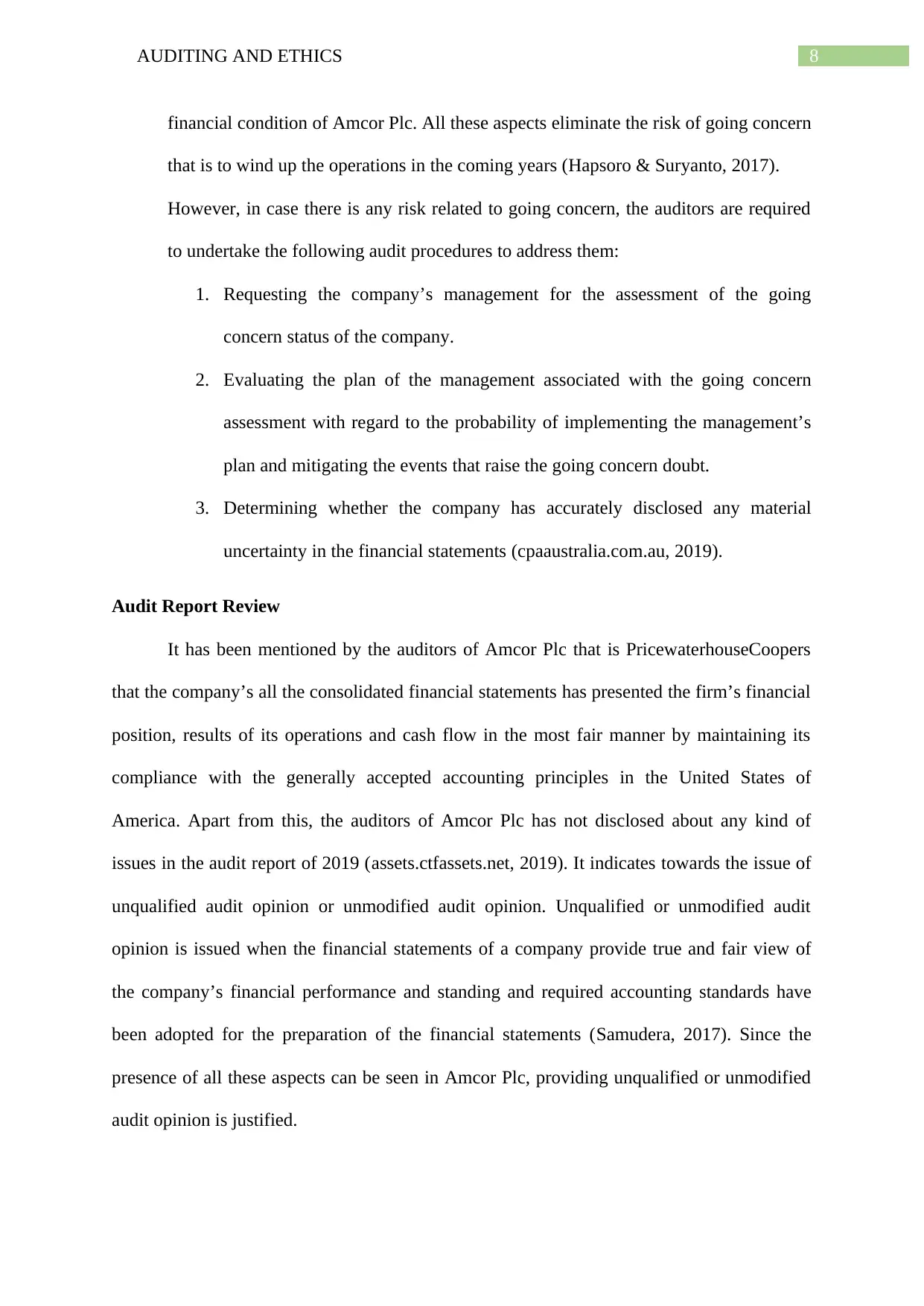
8AUDITING AND ETHICS
financial condition of Amcor Plc. All these aspects eliminate the risk of going concern
that is to wind up the operations in the coming years (Hapsoro & Suryanto, 2017).
However, in case there is any risk related to going concern, the auditors are required
to undertake the following audit procedures to address them:
1. Requesting the company’s management for the assessment of the going
concern status of the company.
2. Evaluating the plan of the management associated with the going concern
assessment with regard to the probability of implementing the management’s
plan and mitigating the events that raise the going concern doubt.
3. Determining whether the company has accurately disclosed any material
uncertainty in the financial statements (cpaaustralia.com.au, 2019).
Audit Report Review
It has been mentioned by the auditors of Amcor Plc that is PricewaterhouseCoopers
that the company’s all the consolidated financial statements has presented the firm’s financial
position, results of its operations and cash flow in the most fair manner by maintaining its
compliance with the generally accepted accounting principles in the United States of
America. Apart from this, the auditors of Amcor Plc has not disclosed about any kind of
issues in the audit report of 2019 (assets.ctfassets.net, 2019). It indicates towards the issue of
unqualified audit opinion or unmodified audit opinion. Unqualified or unmodified audit
opinion is issued when the financial statements of a company provide true and fair view of
the company’s financial performance and standing and required accounting standards have
been adopted for the preparation of the financial statements (Samudera, 2017). Since the
presence of all these aspects can be seen in Amcor Plc, providing unqualified or unmodified
audit opinion is justified.
financial condition of Amcor Plc. All these aspects eliminate the risk of going concern
that is to wind up the operations in the coming years (Hapsoro & Suryanto, 2017).
However, in case there is any risk related to going concern, the auditors are required
to undertake the following audit procedures to address them:
1. Requesting the company’s management for the assessment of the going
concern status of the company.
2. Evaluating the plan of the management associated with the going concern
assessment with regard to the probability of implementing the management’s
plan and mitigating the events that raise the going concern doubt.
3. Determining whether the company has accurately disclosed any material
uncertainty in the financial statements (cpaaustralia.com.au, 2019).
Audit Report Review
It has been mentioned by the auditors of Amcor Plc that is PricewaterhouseCoopers
that the company’s all the consolidated financial statements has presented the firm’s financial
position, results of its operations and cash flow in the most fair manner by maintaining its
compliance with the generally accepted accounting principles in the United States of
America. Apart from this, the auditors of Amcor Plc has not disclosed about any kind of
issues in the audit report of 2019 (assets.ctfassets.net, 2019). It indicates towards the issue of
unqualified audit opinion or unmodified audit opinion. Unqualified or unmodified audit
opinion is issued when the financial statements of a company provide true and fair view of
the company’s financial performance and standing and required accounting standards have
been adopted for the preparation of the financial statements (Samudera, 2017). Since the
presence of all these aspects can be seen in Amcor Plc, providing unqualified or unmodified
audit opinion is justified.
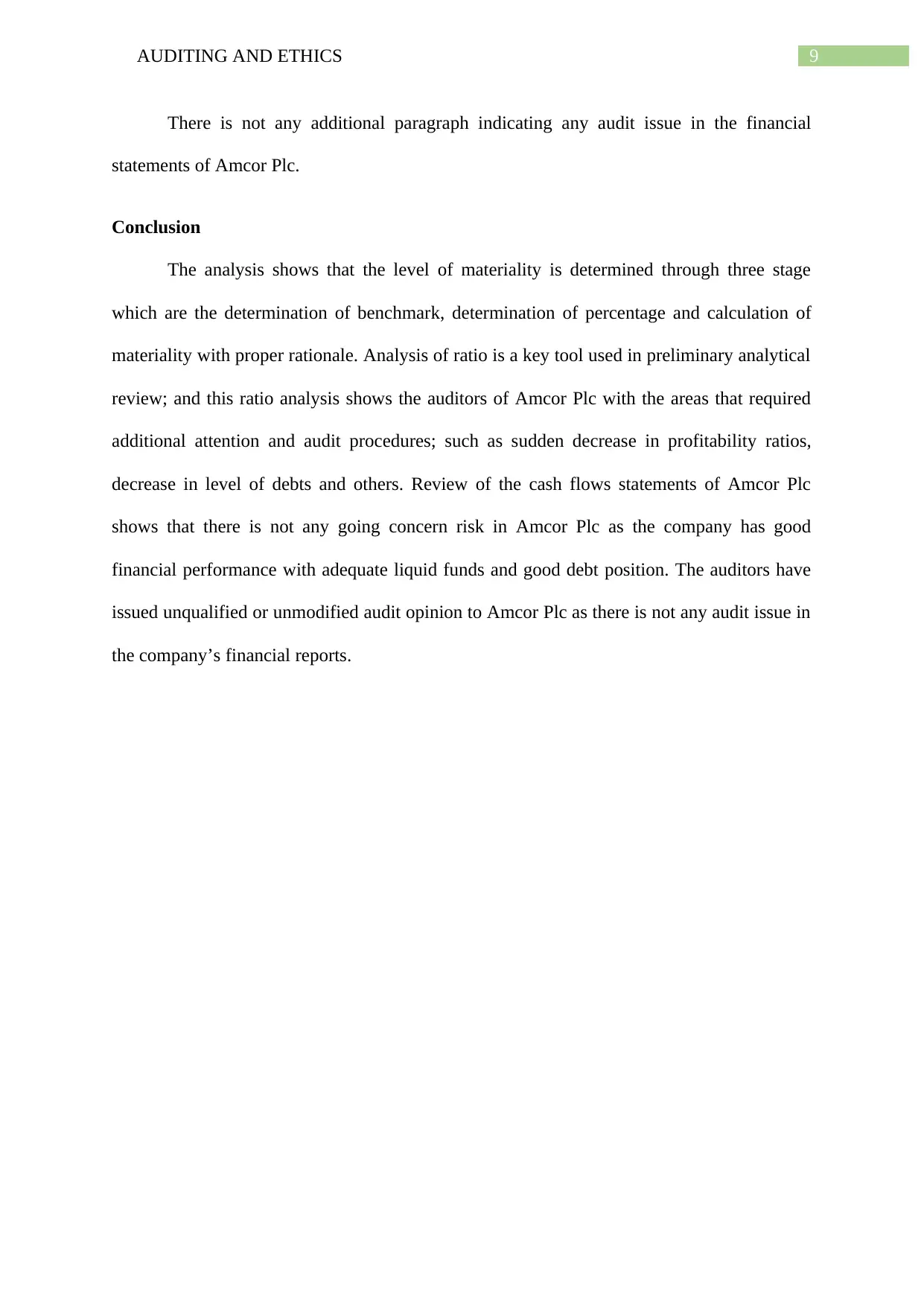
9AUDITING AND ETHICS
There is not any additional paragraph indicating any audit issue in the financial
statements of Amcor Plc.
Conclusion
The analysis shows that the level of materiality is determined through three stage
which are the determination of benchmark, determination of percentage and calculation of
materiality with proper rationale. Analysis of ratio is a key tool used in preliminary analytical
review; and this ratio analysis shows the auditors of Amcor Plc with the areas that required
additional attention and audit procedures; such as sudden decrease in profitability ratios,
decrease in level of debts and others. Review of the cash flows statements of Amcor Plc
shows that there is not any going concern risk in Amcor Plc as the company has good
financial performance with adequate liquid funds and good debt position. The auditors have
issued unqualified or unmodified audit opinion to Amcor Plc as there is not any audit issue in
the company’s financial reports.
There is not any additional paragraph indicating any audit issue in the financial
statements of Amcor Plc.
Conclusion
The analysis shows that the level of materiality is determined through three stage
which are the determination of benchmark, determination of percentage and calculation of
materiality with proper rationale. Analysis of ratio is a key tool used in preliminary analytical
review; and this ratio analysis shows the auditors of Amcor Plc with the areas that required
additional attention and audit procedures; such as sudden decrease in profitability ratios,
decrease in level of debts and others. Review of the cash flows statements of Amcor Plc
shows that there is not any going concern risk in Amcor Plc as the company has good
financial performance with adequate liquid funds and good debt position. The auditors have
issued unqualified or unmodified audit opinion to Amcor Plc as there is not any audit issue in
the company’s financial reports.
Secure Best Marks with AI Grader
Need help grading? Try our AI Grader for instant feedback on your assignments.
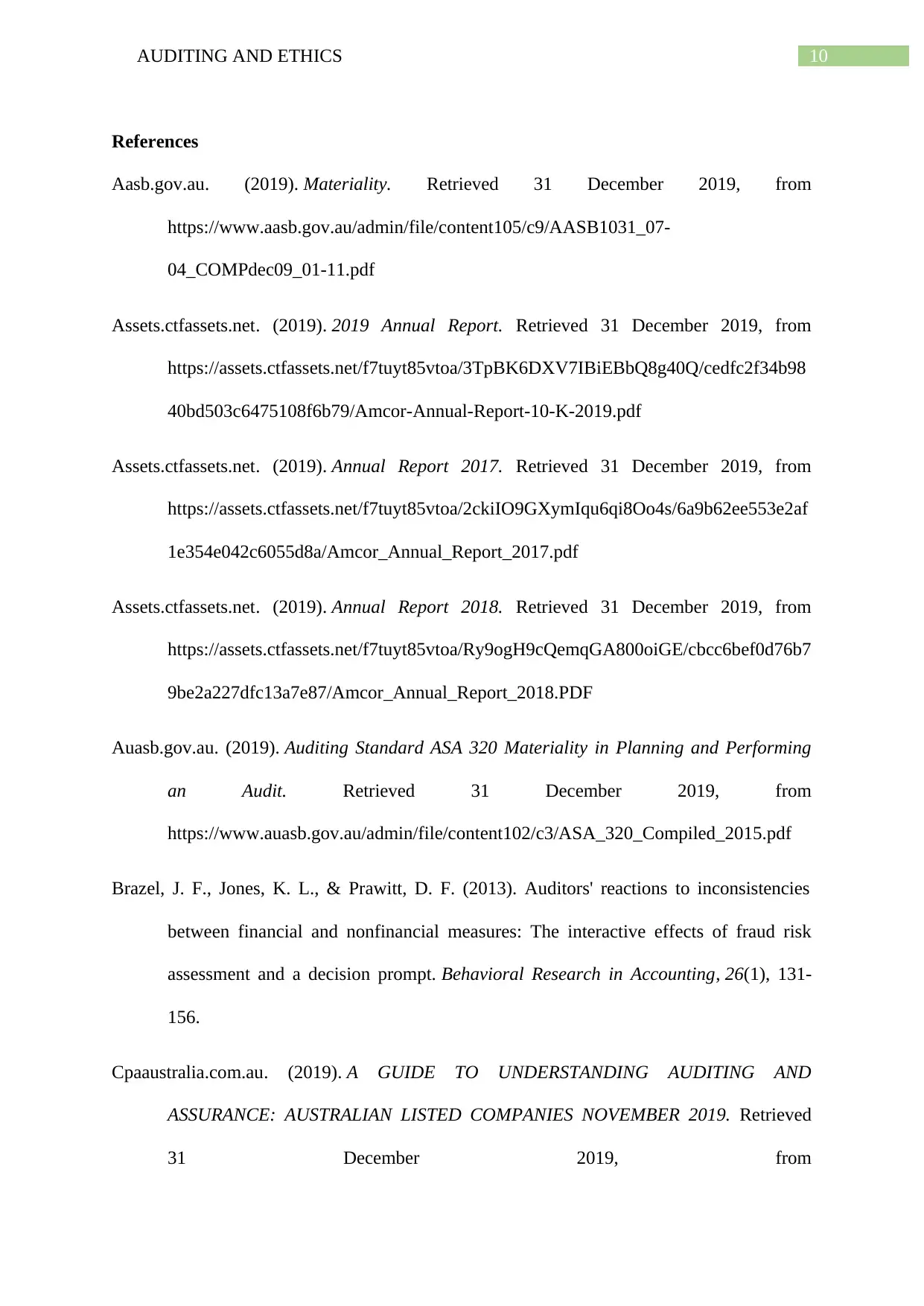
10AUDITING AND ETHICS
References
Aasb.gov.au. (2019). Materiality. Retrieved 31 December 2019, from
https://www.aasb.gov.au/admin/file/content105/c9/AASB1031_07-
04_COMPdec09_01-11.pdf
Assets.ctfassets.net. (2019). 2019 Annual Report. Retrieved 31 December 2019, from
https://assets.ctfassets.net/f7tuyt85vtoa/3TpBK6DXV7IBiEBbQ8g40Q/cedfc2f34b98
40bd503c6475108f6b79/Amcor-Annual-Report-10-K-2019.pdf
Assets.ctfassets.net. (2019). Annual Report 2017. Retrieved 31 December 2019, from
https://assets.ctfassets.net/f7tuyt85vtoa/2ckiIO9GXymIqu6qi8Oo4s/6a9b62ee553e2af
1e354e042c6055d8a/Amcor_Annual_Report_2017.pdf
Assets.ctfassets.net. (2019). Annual Report 2018. Retrieved 31 December 2019, from
https://assets.ctfassets.net/f7tuyt85vtoa/Ry9ogH9cQemqGA800oiGE/cbcc6bef0d76b7
9be2a227dfc13a7e87/Amcor_Annual_Report_2018.PDF
Auasb.gov.au. (2019). Auditing Standard ASA 320 Materiality in Planning and Performing
an Audit. Retrieved 31 December 2019, from
https://www.auasb.gov.au/admin/file/content102/c3/ASA_320_Compiled_2015.pdf
Brazel, J. F., Jones, K. L., & Prawitt, D. F. (2013). Auditors' reactions to inconsistencies
between financial and nonfinancial measures: The interactive effects of fraud risk
assessment and a decision prompt. Behavioral Research in Accounting, 26(1), 131-
156.
Cpaaustralia.com.au. (2019). A GUIDE TO UNDERSTANDING AUDITING AND
ASSURANCE: AUSTRALIAN LISTED COMPANIES NOVEMBER 2019. Retrieved
31 December 2019, from
References
Aasb.gov.au. (2019). Materiality. Retrieved 31 December 2019, from
https://www.aasb.gov.au/admin/file/content105/c9/AASB1031_07-
04_COMPdec09_01-11.pdf
Assets.ctfassets.net. (2019). 2019 Annual Report. Retrieved 31 December 2019, from
https://assets.ctfassets.net/f7tuyt85vtoa/3TpBK6DXV7IBiEBbQ8g40Q/cedfc2f34b98
40bd503c6475108f6b79/Amcor-Annual-Report-10-K-2019.pdf
Assets.ctfassets.net. (2019). Annual Report 2017. Retrieved 31 December 2019, from
https://assets.ctfassets.net/f7tuyt85vtoa/2ckiIO9GXymIqu6qi8Oo4s/6a9b62ee553e2af
1e354e042c6055d8a/Amcor_Annual_Report_2017.pdf
Assets.ctfassets.net. (2019). Annual Report 2018. Retrieved 31 December 2019, from
https://assets.ctfassets.net/f7tuyt85vtoa/Ry9ogH9cQemqGA800oiGE/cbcc6bef0d76b7
9be2a227dfc13a7e87/Amcor_Annual_Report_2018.PDF
Auasb.gov.au. (2019). Auditing Standard ASA 320 Materiality in Planning and Performing
an Audit. Retrieved 31 December 2019, from
https://www.auasb.gov.au/admin/file/content102/c3/ASA_320_Compiled_2015.pdf
Brazel, J. F., Jones, K. L., & Prawitt, D. F. (2013). Auditors' reactions to inconsistencies
between financial and nonfinancial measures: The interactive effects of fraud risk
assessment and a decision prompt. Behavioral Research in Accounting, 26(1), 131-
156.
Cpaaustralia.com.au. (2019). A GUIDE TO UNDERSTANDING AUDITING AND
ASSURANCE: AUSTRALIAN LISTED COMPANIES NOVEMBER 2019. Retrieved
31 December 2019, from
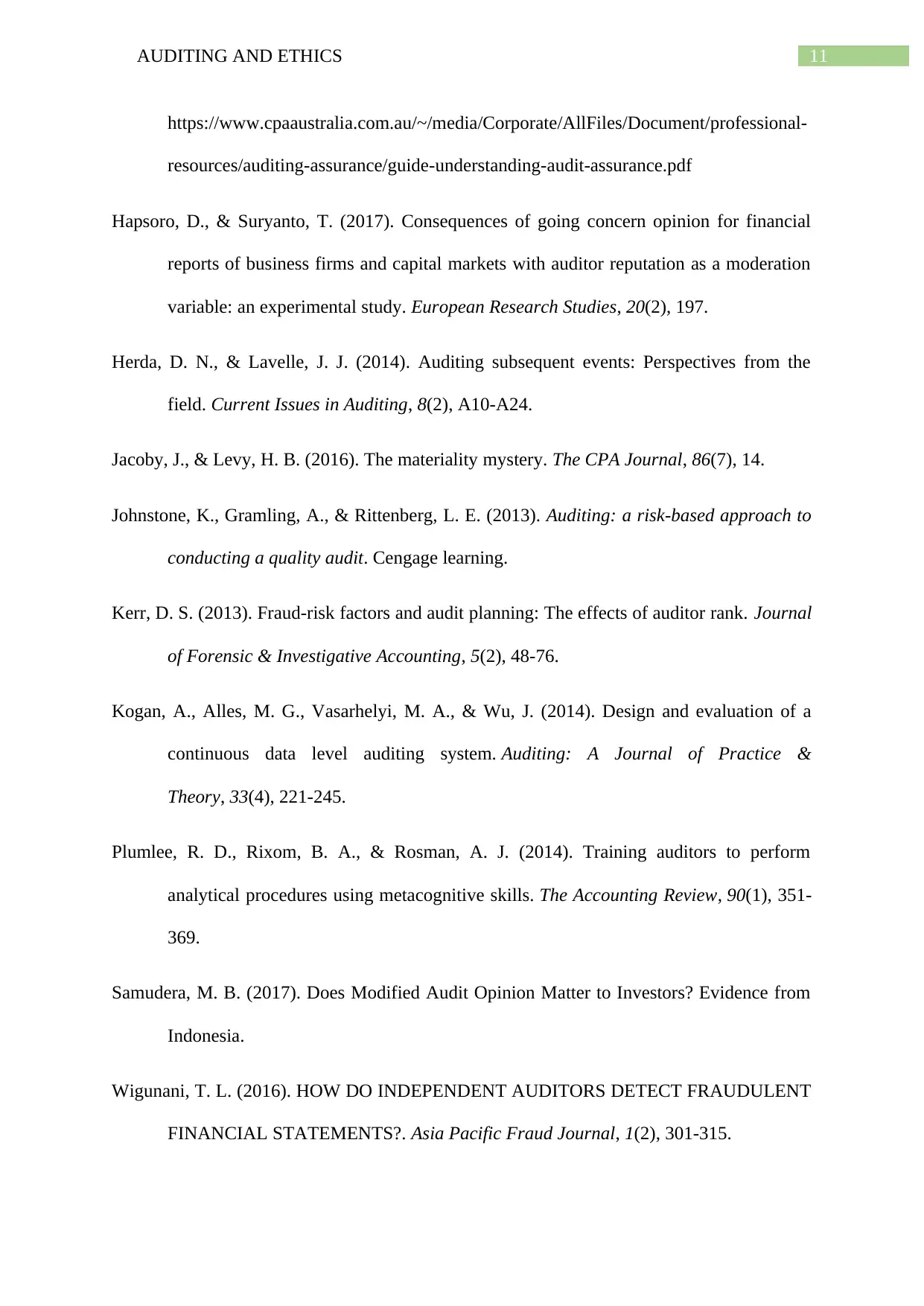
11AUDITING AND ETHICS
https://www.cpaaustralia.com.au/~/media/Corporate/AllFiles/Document/professional-
resources/auditing-assurance/guide-understanding-audit-assurance.pdf
Hapsoro, D., & Suryanto, T. (2017). Consequences of going concern opinion for financial
reports of business firms and capital markets with auditor reputation as a moderation
variable: an experimental study. European Research Studies, 20(2), 197.
Herda, D. N., & Lavelle, J. J. (2014). Auditing subsequent events: Perspectives from the
field. Current Issues in Auditing, 8(2), A10-A24.
Jacoby, J., & Levy, H. B. (2016). The materiality mystery. The CPA Journal, 86(7), 14.
Johnstone, K., Gramling, A., & Rittenberg, L. E. (2013). Auditing: a risk-based approach to
conducting a quality audit. Cengage learning.
Kerr, D. S. (2013). Fraud-risk factors and audit planning: The effects of auditor rank. Journal
of Forensic & Investigative Accounting, 5(2), 48-76.
Kogan, A., Alles, M. G., Vasarhelyi, M. A., & Wu, J. (2014). Design and evaluation of a
continuous data level auditing system. Auditing: A Journal of Practice &
Theory, 33(4), 221-245.
Plumlee, R. D., Rixom, B. A., & Rosman, A. J. (2014). Training auditors to perform
analytical procedures using metacognitive skills. The Accounting Review, 90(1), 351-
369.
Samudera, M. B. (2017). Does Modified Audit Opinion Matter to Investors? Evidence from
Indonesia.
Wigunani, T. L. (2016). HOW DO INDEPENDENT AUDITORS DETECT FRAUDULENT
FINANCIAL STATEMENTS?. Asia Pacific Fraud Journal, 1(2), 301-315.
https://www.cpaaustralia.com.au/~/media/Corporate/AllFiles/Document/professional-
resources/auditing-assurance/guide-understanding-audit-assurance.pdf
Hapsoro, D., & Suryanto, T. (2017). Consequences of going concern opinion for financial
reports of business firms and capital markets with auditor reputation as a moderation
variable: an experimental study. European Research Studies, 20(2), 197.
Herda, D. N., & Lavelle, J. J. (2014). Auditing subsequent events: Perspectives from the
field. Current Issues in Auditing, 8(2), A10-A24.
Jacoby, J., & Levy, H. B. (2016). The materiality mystery. The CPA Journal, 86(7), 14.
Johnstone, K., Gramling, A., & Rittenberg, L. E. (2013). Auditing: a risk-based approach to
conducting a quality audit. Cengage learning.
Kerr, D. S. (2013). Fraud-risk factors and audit planning: The effects of auditor rank. Journal
of Forensic & Investigative Accounting, 5(2), 48-76.
Kogan, A., Alles, M. G., Vasarhelyi, M. A., & Wu, J. (2014). Design and evaluation of a
continuous data level auditing system. Auditing: A Journal of Practice &
Theory, 33(4), 221-245.
Plumlee, R. D., Rixom, B. A., & Rosman, A. J. (2014). Training auditors to perform
analytical procedures using metacognitive skills. The Accounting Review, 90(1), 351-
369.
Samudera, M. B. (2017). Does Modified Audit Opinion Matter to Investors? Evidence from
Indonesia.
Wigunani, T. L. (2016). HOW DO INDEPENDENT AUDITORS DETECT FRAUDULENT
FINANCIAL STATEMENTS?. Asia Pacific Fraud Journal, 1(2), 301-315.
1 out of 12
Your All-in-One AI-Powered Toolkit for Academic Success.
+13062052269
info@desklib.com
Available 24*7 on WhatsApp / Email
![[object Object]](/_next/static/media/star-bottom.7253800d.svg)
Unlock your academic potential
© 2024 | Zucol Services PVT LTD | All rights reserved.





